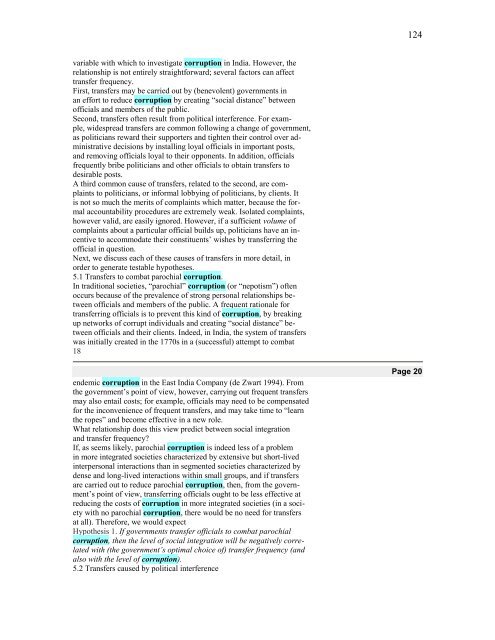FILSAFAT KORUPSI - Direktori File UPI
FILSAFAT KORUPSI - Direktori File UPI
FILSAFAT KORUPSI - Direktori File UPI
Create successful ePaper yourself
Turn your PDF publications into a flip-book with our unique Google optimized e-Paper software.
variable with which to investigate corruption in India. However, the<br />
relationship is not entirely straightforward; several factors can affect<br />
transfer frequency.<br />
First, transfers may be carried out by (benevolent) governments in<br />
an effort to reduce corruption by creating “social distance” between<br />
officials and members of the public.<br />
Second, transfers often result from political interference. For exam-<br />
ple, widespread transfers are common following a change of government,<br />
as politicians reward their supporters and tighten their control over ad-<br />
ministrative decisions by installing loyal officials in important posts,<br />
and removing officials loyal to their opponents. In addition, officials<br />
frequently bribe politicians and other officials to obtain transfers to<br />
desirable posts.<br />
A third common cause of transfers, related to the second, are com-<br />
plaints to politicians, or informal lobbying of politicians, by clients. It<br />
is not so much the merits of complaints which matter, because the for-<br />
mal accountability procedures are extremely weak. Isolated complaints,<br />
however valid, are easily ignored. However, if a sufficient volume of<br />
complaints about a particular official builds up, politicians have an in-<br />
centive to accommodate their constituents‟ wishes by transferring the<br />
official in question.<br />
Next, we discuss each of these causes of transfers in more detail, in<br />
order to generate testable hypotheses.<br />
5.1 Transfers to combat parochial corruption.<br />
In traditional societies, “parochial” corruption (or “nepotism”) often<br />
occurs because of the prevalence of strong personal relationships be-<br />
tween officials and members of the public. A frequent rationale for<br />
transferring officials is to prevent this kind of corruption, by breaking<br />
up networks of corrupt individuals and creating “social distance” be-<br />
tween officials and their clients. Indeed, in India, the system of transfers<br />
was initially created in the 1770s in a (successful) attempt to combat<br />
18<br />
endemic corruption in the East India Company (de Zwart 1994). From<br />
the government‟s point of view, however, carrying out frequent transfers<br />
may also entail costs; for example, officials may need to be compensated<br />
for the inconvenience of frequent transfers, and may take time to “learn<br />
the ropes” and become effective in a new role.<br />
What relationship does this view predict between social integration<br />
and transfer frequency?<br />
If, as seems likely, parochial corruption is indeed less of a problem<br />
in more integrated societies characterized by extensive but short-lived<br />
interpersonal interactions than in segmented societies characterized by<br />
dense and long-lived interactions within small groups, and if transfers<br />
are carried out to reduce parochial corruption, then, from the govern-<br />
ment‟s point of view, transferring officials ought to be less effective at<br />
reducing the costs of corruption in more integrated societies (in a soci-<br />
ety with no parochial corruption, there would be no need for transfers<br />
at all). Therefore, we would expect<br />
Hypothesis 1. If governments transfer officials to combat parochial<br />
corruption, then the level of social integration will be negatively corre-<br />
lated with (the government’s optimal choice of) transfer frequency (and<br />
also with the level of corruption).<br />
5.2 Transfers caused by political interference<br />
124<br />
Page 20

















